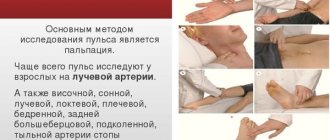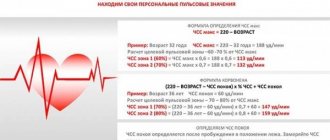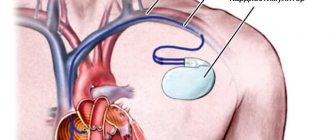Beginning athletes or those who simply decided to lose weight usually have no idea how heart rate relates to sports. However, professional athletes can confirm that there is an optimal heart rate for fat burning, which will help you get rid of those hated extra pounds much faster and easier. Let's look at the subtleties and nuances of this issue so that everything falls into place.
Pulse zones during sports
Those working in the gym with a trainer sometimes do not understand why he periodically asks for a control heart rate measurement. Those who decide to join the sport on their own can completely ignore their heart rate. But first, it doesn’t hurt to find out what a pulse is.
A pulse or pulse wave is a cardiac contraction that also extends to the walls of blood vessels. The normal heart rate (HR) for a person at complete rest is considered to be from 60 to 90 beats per minute.
It is most convenient to measure the pulse in places where the arteries are located fairly close under the skin. First of all, this is the radial artery, where doctors usually take measurements. Athletes often use the carotid artery for this, and you can also calculate heart rate in the groin, where there is also an artery close to the skin.
What does knowing your heart rate do when training?
To figure out how to calculate your heart rate for fat burning, it doesn’t hurt to first find out why such indicators might be useful to you. It's all quite simple. They can be considered the main parameter of how the calories you absorb from food are spent. That is, having understood the pulse zones, which we will talk about below, you will know exactly how effective your workouts are.
To better understand the problem, a professional runner can run quite fast even at a low heart rate. At the same time, a beginner at the track or gym will immediately increase his “fat-burning pulse” without even thinking about it.
One more nuance should be noted, without which the picture will not be complete. Constant, systematic training at the “limit”, that is, with a seriously elevated heart rate, can place an extremely high load on the athlete’s body. This behavior can ultimately cause quite serious health problems. Therefore, professional trainers recommend clearly monitoring your heart rate during the training process.
Five heart rate zones
There are exactly five zones in total, by identifying which you can easily find out at what heart rate fat is burned in women or men. Each subsequent one differs from the previous one in that the pulse gradually increases. In fact, the first of them implies the minimum possible load, and the last - the maximum possible. Let's look at this point in more detail.
Zone 1: Therapy and Recovery
To calculate your heart rate zone for fat burning, you first need to understand what a low-intensity health zone is. It is also called the white zone to make it easier to remember. It lies in the area of 50-60% of the maximum heart rate. The norm can be considered 115-120 beats per minute, that is, almost two beats per second.
Training at such heart rate indicators allows us to talk about a general healing effect. In addition, it slowly prepares the body for heavier loads. This will be the easiest, most accessible workout, which is recommended even for people who have previously suffered injuries or are undergoing rehabilitation after illness.
Zone 2: Warm up before real work
The pulse in this zone rises higher; it should be 55-70% of the maximum heart rate. The normal frequency is 120-135 beats per minute. As the name implies, work in this plane will train the athlete’s agility, endurance and endurance. It is also called blue.
Training with such a pulse ensures the mobilization of lipids and their transport to the muscles. Thanks to this, the number of capillaries, their density increases, and at the same time the quality of the muscle fibers themselves. All tissues are much better saturated with oxygen, which further accelerates metabolic processes in the body.
For example, we can indicate that training in the second zone is standard, familiar to any professional runner. At the same time, the body burns up to eighty-five percent of fat, with fifteen percent of carbohydrates and only five to ten proteins. The respiratory system is brought back to normal, and at the same time the performance and general condition of the cardiovascular system significantly improves.
Zone 2: Aerobic Exercise and Cardio
This heart rate zone is best for training. The heart rate in it should reach 65% or 70% of the maximum possible values. In this case, the heart should contract at a frequency of 130-155 beats per minute. This zone is called the green zone because it is best suited for any endurance training or aerobic exercise. For example, running exercises allow us to talk not only about the formation of new body capabilities, but also about changes in physiological characteristics - a serious increase in the number of capillaries.
The size, and at the same time the number of blood vessels, increases. It is believed that even the size and strength of the heart itself increases. As a result, the resting heart rate also increases. Blood circulation improves in the heart and skeletal muscles. It is at this pulse rate that lactic acid begins to enter the blood.
Zone 3: Strength Training
The third pulse zone is also called anaerobic or yellow. The heart rate in it can reach from 70% to 80% of the maximum. In this case, 155-165 beats per minute can be considered the norm. Working in this zone will not only help you develop strength endurance, but also maximize your performance. At the same time, due to the intensity of movements, there is not enough oxygen for the cells to oxidize. Therefore, they switch to a special, oxygen-free anaerobic regime. This means that practically no fats are burned, and carbohydrates are used as “fuel”.
Zone 4: border
This zone is also called the endurance zone or the second yellow zone. At 75-85% of your maximum heart rate, your heart rate is 150-180 beats per minute, which is approximately three per second.
This way you can “work off” harmful foods consumed the day before. However, you need to understand that working for a long time in this pulse zone is not recommended. The thing is that just at this moment lactic acid begins to be actively released. It makes you feel tired. It can only be used as a short-term strength load, not often and with great caution.
Zone 5: dangerous
The fifth, maximum or red zone is the one at which a person’s pulse reaches its maximum (90-100%). In this case, its frequency can be 175-185 beats per minute. Training in it develops maximum performance. However, we must not forget that in this case the entire body works under maximum load, on the verge of breakdown, at the very limit of its capabilities. It was with this pulse that many athletes showed their best results, becoming world or Olympic champions.
All body systems begin to work with maximum efficiency, ensuring survival under enormous loads. At the same time, lactic acid accumulates in the blood, so you definitely won’t be able to work with such intensity for a long time. Ordinary amateur athletes should be wary of pushing their body to such levels, as this can be dangerous to health and even life.
At what heart rate does fat burning occur?
Based on what is written above, we can draw a logical conclusion that the fitness zone will allow you to burn excess fat most efficiently, which is characterized by indicators of 130-155 beats per minute. It is during this period that the body begins to actively extract fats from its reserves and convert them into energy.
In this case, you will be able to effectively lose weight without exposing yourself to excessive stress. But we must not forget that the training must last at least forty minutes, otherwise nothing will work. In fact, this is actually the optimal heart rate for burning fat, without exhausting yourself, which can be dangerous.
Recommendations and rules for training
By increasing the load and heart rate above 70% of the maximum heart rate, you can break down much more fat deposits. But for people who have just started their sports journey, this option is not suitable. Experts advise them to start with exercises that increase their heart rate to 50% of their maximum. And only after a couple of weeks, gradually increase the intensity of the load.
Once the body gets used to the exercise routine and the heart muscle strengthens, you can move on to high-intensity interval training for increased fat burning. They help both activate metabolic processes and significantly reduce the percentage of fat deposits (especially in the abdominal area). This type of training involves alternately performing complex and easier exercises, during which the heart rate either accelerates or slows down, which provides a good shake-up for the body.
Among the beneficial properties of such trainings, we should also highlight:
- decrease in blood pressure;
- increasing endurance;
- maintaining muscle mass;
- improved insulin perception;
- normalization of cholesterol levels in the blood;
- reduction of belly fat.
When developing such programs, you should decide on the duration, intensity and frequency of both load and recovery intervals.
At the peak, the pulse should not go beyond 80% of the maximum, and at the decline it is not advisable for it to fall below 40-50%.
Any physical activity will promote fat burning, but if you want to get rid of fat as quickly as possible, then you can’t do without interval training.
Heart rate calculation for fat burning zone (FZZ)
Heart rate readings can vary greatly among different people, depending on gender and age. Therefore, it makes sense not just to focus on average indicators, but to understand thoroughly how to correctly calculate the heart rate for burning fat.
Calculation formula based on the maximum heart rate method
The most common empirical formula for calculation is two hundred twenty minus age. It is called the Haskell-Fox formula, and it is also approximate. After all, it only takes into account the years a person has lived. It is worth knowing that it has absolutely no scientific basis. It is used mainly because it is very simple and does not require special knowledge. For the majority of people, it will indeed be quite enough. However, there is also a refined version of it.
HRmax = 205.8 - (0.685 x age)
Where:
HRmax is the result, that is, the maximum number of heartbeats for a particular person.
Age – a person’s age in years.
Calculating heart rate using Karvonen's formula
The work of the Finnish physiologist Martti Karvonen allowed scientists to much more accurately calculate not only the MHR, but also calculate it for certain load zones (warm-up, training, cool-down). It looks like this.
- Training heart rate = (maximum heart rate - resting heart rate) x percentage intensity + resting heart rate.
Any schoolchild, based on school knowledge of mathematics, will be able to transform such a calculation in order to calculate the required intensity of training.
- Percent Intensity = (Training Heart Rate - Resting Heart Rate) / (Maximum Heart Rate - Resting Heart Rate).
This will help determine the indicators for optimal fat-burning training. In many ways, everything will depend on the initial condition of the athlete and his age.
Karvonen formula for women
The physiology of women is somewhat different from that of men. It makes sense for the poet to figure out what the calculation will look like for representatives of the beautiful part of humanity.
(220 – age – resting heart rate) x intensity factor + resting heart rate
*It is best to calculate your heart rate at rest early in the morning, just after waking up. In this case, the correct intensity coefficient is considered to be seventy percent of the maximum indicator. For example, let's calculate for a woman aged 34 years.
(220 – 34 – 70) x 0.3 + 70 = 104.8
Thus, the optimal heart rate for fat burning starts at 104 beats per minute.
Karvonen formula for men
When calculating the heart rate formula for burning fat in men, intensity coefficients from 0.5 to 0.8 are used, that is, from minimum to maximum. As an example, let's calculate the initial heart rate for a forty-five-year-old man.
(220 – 45 – 65) x 0.5 + 65 = 120
It turns out that the start of lipid burning will be exactly 120 beats per minute. However, it must be taken into account that as the duration of training increases, the coefficient will need to be increased. As a result, we will get a figure of 150-153 beats per minute, at the highest rate.
Heart rate zone for fat burning is absolutely not important when losing weight
I haven't had a single workout in the last three weeks. And I can show you my activity through a fitness tracker.
It all started on June 3, when I weighed 103.3 kilograms. That is, for the first week I walked a certain number of steps completely normally, on average 10,000 per day. At the end of the first week, I (safely) blew out my back, and for the second week I simply couldn't get off the couch. I could barely walk, with a stick. Third week - I started to walk a little, but also very little. In the second and third weeks, I walked a total of about 20,000 steps - that's only 1,400 steps a day. Normal movement around the house, from the sofa to the kitchen and toilet.
Dynamics of weight loss over three weeks
As you can imagine, during these three weeks my heart rate never rose above 130 (75% of max heart rate). And there was not a single training session. That is, the heart rate zone for fat burning was never reached. And despite this, in these three weeks I lost 5.1 kilograms. On average - 1.7 kilograms per week. Why did this happen?
Calculating heart rate for cardio training: optimal standards
The simplest method to calculate your pulse is to count the beats for ten seconds and then multiply by six. Perhaps you can’t count on great accuracy here, but this is a simple method that is accessible to everyone. To increase the accuracy of measurements, it is best to buy a special device in a store or pharmacy - a heart rate monitor. This function is available in almost any fitness bracelet.
Among cardio, moderate and moderate loads are considered the most effective for eliminating excess fat deposits. So, even 15-20 minutes of working at the limit of your capabilities with 80% of the MHR will bring much less benefit than 30-45 minutes of activity with heart rate no higher than 6-75%. Therefore, it is not recommended to strive for excessively intense training; results will not be improved in this way.
In different pulse zones, the heart provides different oxygen access to tissues. It is on this, as we found out, that the effectiveness of training in terms of weight loss directly depends. Let's find out what processes can be detected at the boundaries of these phases.
- At 60-70% of the maximum, carbohydrates begin to be actively burned, and only after this is it time for lipolysis. Therefore, in order to get rid of excess fat in this way, you will have to work for at least forty-five minutes, or even better, an hour.
- A more intense workout at 70-80%, that is, in the green heart rate zone, is more suitable for professional athletes and not for beginner athletes. They can combine cardio and strength training to effectively burn fat.
- At 80-90% of MHR, all lipid burning stops completely. Oxygen stops flowing to the tissues, so a completely different process begins that destroys the muscles.
In order for the results to be pleasing, you need to approach things wisely. So the optimal mode for burning fat will be a regular, systematic change of exercise regimen. This causes inevitable stress in the body. To get rid of shock, the body begins to actively break down deposits of fat stored in advance, converting them into energy for fuel. The main thing here is not to overdo it. For the rest, you need to focus on the formulas provided above, then questions about what heart rate is most optimal for burning fat during cardio will no longer arise.
Online heart rate calculator for fat burning
To really simplify your task, you can do without a thorough study of the issue. There are simple online resources available to everyone that allow you to calculate the heart rate necessary for fat burning. These calculators are easy to use.
- Enter your age in the field provided.
- Use your fingers to find an area in the lower part of the neck where the pulse can be heard well.
- Next, use the mouse to left-click in time with your heartbeat.
As a result, the program itself will make the calculation, show your average heart rate, and at the same time highlight the most effective pulse zone for burning fat.
How to create a fat burning program
Often, beginners do not understand how to create an exercise plan for weight loss correctly. Therefore, even during grueling workouts, they are surprised to notice that ugly folds on the sides, stomach or thighs do not go away as much as they would like. It is necessary to gradually increase the heart rate to seventy percent of the maximum so that the body has time to adapt to physical activity. A proper training program must comply with certain rules.
- From three to five to seven minutes should always be allocated for warming up the body.
- Next, do high-intensity exercises for thirty seconds. For example, sprinting or active jumping rope are good options.
- After this, you need to give the body a break, but do not allow the pulse to completely drop to a resting state. Therefore, you can simply walk, even on the spot, for one minute.
- Within ten to fifteen minutes, the first three points need to be alternated.
It is also useful to finish your workout by walking. Only you can allocate a little more time to it - three or five minutes.
Subjective methods for assessing cardio intensity
To determine your heart rate without measuring it, simply place your hands on the metal handrails of most treadmills in the gym. However, they are not always at hand, and not everyone who wants to lose weight has a heart rate monitor. Ideally, the best fat burning occurs if you can say a phrase of five or six words during exercise without particularly straining.
- Excessively light . During such activities, the load does not interfere with the conversation at all.
- Easy . You have to speak with slight effort.
- Medium-light . It becomes more difficult to talk, but not particularly so.
- Moderate . To maintain a conversation you already need to make an effort.
- Medium-high . It becomes difficult to pronounce words, there is not enough breath.
- High . Any words can be said only with a fairly significant effort.
- Overpriced . It’s no longer possible to speak.
All this is very subjective, so you shouldn’t rely heavily on such data. But in order to determine offhand which pulse zone you are working in, this will be quite enough for the first time.
How energy is used in our body
Look. In general, our body is very cleverly designed. And it’s easier for him to start expending calories that are free in our blood and in our muscles. That is, there is glucose in the blood, glycogen is in the muscles.
Winners' sports nutrition. Susan Kleiner.
And, according to various sources (Sports Nutrition for Winners. Greenwood-Robinson, Kleiner), our body contains from 700 to 800 of these “fast calories” at a time. About 350 calories of energy are in the form of glucose in the blood, and about 350 more calories are contained in your muscles in the form of glycogen .
Until you use , and until oxygen begins to flow to your muscles, fat will not begin to be burned.
In general, very interesting studies have been conducted that the body of an adult male contains approximately 4 liters of fat. And this energy is enough to ride a bicycle “without recharging” from Moscow to Novosibirsk. And this is approximately 3200 kilometers.
The catch is that if we want to start using this energy normally, we first need to train our body. And this is called fat metabolism. This can be done through training. Through long-term training sessions that take at least one hour.
Running to burn fat
One of the simplest and most accessible exercises for everyone that is good for burning fat is running. It does not require additional equipment or even attendance for classes. You can run in the gym on a treadmill, at home on site, in a nearby park, and anywhere. At the same time, there is no need for increased speed, because we will not be working for records, but for losing weight. It is optimal to take a slow pace, but at the same time increasing the duration of the run to twenty minutes or half an hour.
What you need to know while running
Many people prefer to run in the morning, believing that fat is burned most optimally during this period. There is some truth to this, but it is not all there is to know. At night, the level of glycogen in the blood decreases noticeably. In fact, by running on an empty stomach, you force the body to immediately take in lipids as an energy boost.
However, many scientists believe that it may be dangerous to health. After all, the body has not yet fully woken up after a night's rest. Excessive sudden stress can negatively affect the heart and the functioning of the cardiovascular system. However, this opinion has not yet been practically confirmed by science. However, you can run at any hour of the day that seems best to you.











